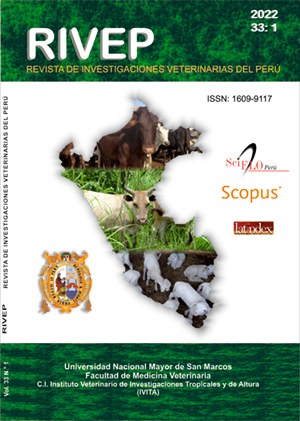Microplastics in the “hairy crab” Romaleon setosum (Molina, 1782) (Cancridae) from Peru
DOI:
https://doi.org/10.15381/rivep.v33i1.22161Keywords:
crustacean, marine environment, pollution, microplastic fibers, microplastic fragments, Romaleon setosumAbstract
The aim of this study was to characterize the microplastics (MP) in the hairy crab Romaleon setosum (Molina, 1782) (Cancridae), a species of importance for human consumption. In total, 15 individuals of R. setosum acquired between December 2020 and January 2021 at the Ventanilla Fisheries Wholesale Market, Callao, Peru were evaluated. The muscle, gill and digestive tract of each crab was digested with 10% KOH, followed by a filtration process to search for MP. All individuals presented MP in muscle, gills and digestive tract. Blue MP fibres were most abundant in muscle, blue and red fibres in the gill, and black and blue in the digestive tract. In the case of film-type PM, white was the dominant colour in the muscle and digestive tract, while green was observed in the gills. For the fragments, the blue colour was the most abundant in the gill and in the digestive tract, not being observed in the muscle. The number of PM particles were present with the following sequence: digestive tract > gill > muscle and in relation to its shape it was fibre > fragment > film. The blue and black MPs were the dominant ones. The length of the cephalothorax was related to the number of total PM particles, to muscle and to the blue colour.
Downloads
Downloads
Published
Issue
Section
License
Copyright (c) 2022 José Iannacone, Fabiola Príncipe, Lorena Alvariño, David Minaya, Grober Panduro, Yuri Ayala

This work is licensed under a Creative Commons Attribution 4.0 International License.
AUTHORS RETAIN THEIR RIGHTS:
a. Authors retain their trade mark rights and patent, and also on any process or procedure described in the article.
b. Authors retain their right to share, copy, distribute, perform and publicly communicate their article (eg, to place their article in an institutional repository or publish it in a book), with an acknowledgment of its initial publication in the Revista de Investigaciones Veterinarias del Perú (RIVEP).
c. Authors retain theirs right to make a subsequent publication of their work, to use the article or any part thereof (eg a compilation of his papers, lecture notes, thesis, or a book), always indicating the source of publication (the originator of the work, journal, volume, number and date).



